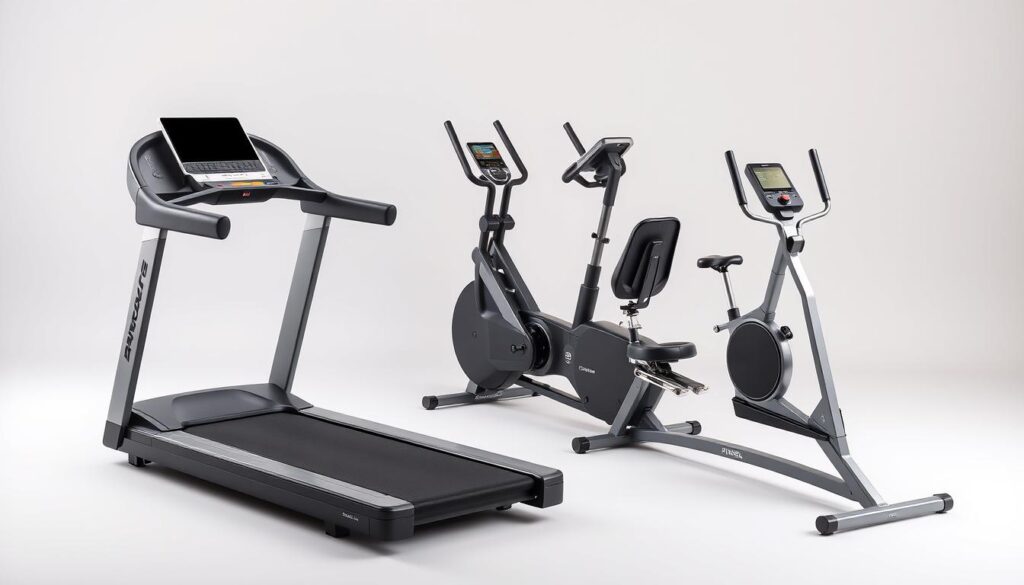Maximize Your Fitness with These Cardio Workouts
Cardio exercises are key for a healthy life. The American College of Sports Medicine says you need 150–300 minutes a week of moderate activity. This boosts heart health and overall wellness.
Whether you’re new or experienced, you can do cardio workouts like walking, dancing, or stair climbing anywhere. These activities increase your heart rate and breathing. They strengthen your heart and lungs over time.
You don’t need a gym for effective cardio workouts. A 10-minute walk or 30 minutes of boxing can burn up to 400 calories. This improves heart health.
The CDC suggests 150 minutes of moderate cardio weekly to keep your weight in check. Begin with a 5-minute warmup, like light jogging, to stay safe. Swimming or jumping rope are also good options, offering flexibility for your schedule.
Key Takeaways
- Aim for 150–300 minutes of cardio workouts weekly per ACSM guidelines.
- Use a Rate of Perceived Exertion (RPE) of 3–7 to gauge moderate to vigorous effort.
- Moderate exercise equals 100 steps per minute, while vigorous exceeds that rate.
- Consistent cardio reduces heart disease risk and boosts longevity, as shown by the Mayo Clinic.
- Even 10 minutes of walking daily can start improving heart health immediately.
Benefits of Cardio Workouts
Regular cardio workouts do more than just keep you fit. They protect your health in many ways. Whether it’s running, cycling, or dancing, these workouts are good for you.
Boosts Heart Health
- Strengthens heart muscle, lowering blood pressure and resting heart rate.
- Raises HDL (good cholesterol) while reducing unhealthy triglycerides.
- Studies show active seniors had less brain tissue loss in critical areas compared to sedentary peers.
“Physical activity may reduce dementia risk regardless of age,” noted in a 2023 study on aging and exercise.
Enhances Mood and Mental Clarity
Cardio workouts make you feel good by releasing endorphins and serotonin. This improves your mood right away. Research shows regular activity can:
- Reduce depression symptoms by 40% in clinical trials.
- Improve sleep quality and help you fall asleep faster.
- Enhance focus and memory.
Supports Weight Loss
Exercise burns calories and boosts your metabolism after you stop. Studies prove:
- Overweight individuals lost 4.3–5.7% of body weight with 5 weekly sessions.
- Combining cardio with healthy eating improves blood sugar and insulin sensitivity.
Even short 10-minute workouts help meet the American Heart Association’s weekly exercise goal.
Different Types of Cardio Workouts
Choosing the right cardio workout depends on your goals. Explore these three approaches to find what fits your routine:
Steady-State Cardio
Aerobic training like jogging or cycling at a steady pace strengthens endurance. Aim for 30-60 minutes, keeping your heart rate at 60-70% of your maximum. This low-impact option is ideal for beginners and recovery days.
High-Intensity Interval Training (HIIT)
HIIT involves short bursts of maximum effort followed by rest, like 30 seconds sprinting then 10 seconds resting. This high-intensity interval training boosts metabolism and burns calories even after your session.
“Interval training challenges your body and maximizes calorie burn,” says Dr. Saju Mathew.
Workouts last 15-30 minutes but deliver intense results. Examples include burpees or mountain climbers paired with rest intervals.
Circuit Training
Combine resistance exercises with minimal rest to build strength and cardio endurance. A circuit might include squats, push-ups, and lunges done back-to back for 20-40 minutes. This full-body approach improves muscle tone while elevating your heart rate.
| Type | Steady-State | HIIT | Circuit Training |
|---|---|---|---|
| Key Benefit | Endurance building | Post-workout calorie burn | Strength + cardio |
| Examples | Brisk walking | Jump rope intervals | Squats + push-ups |
| Duration | 30-60 min | 15-30 min | 20-40 min |
Choosing the Right Cardio Workout for You
Only 20% of adults meet weekly exercise targets. To find the best cardio routines, start by checking your current fitness. Your endurance exercises and goals depend on this step.
Assessing Your Fitness Level
Use the Rate of Perceived Exertion (RPE) scale (1–10) to gauge intensity. Moderate efforts (RPE 3–4) let you chat easily. Vigorous efforts (5–7) limit conversation. Track recovery heart rate and listen to your body’s limits.
Setting Realistic Goals
Follow US guidelines: 150 minutes moderate or 75 vigorous weekly. Build endurance exercises gradually. Pair goals like weight management or heart health with achievable milestones. Adjust based on progress.
Personal Preferences
Pick activities you enjoy. Love dancing? Try Zumba or dance-based workouts. Prefer low-impact options? Ellipticals or swimming reduce strain. Matching workouts to your tastes ensures long-term adherence to your best cardio routines.
Outdoor Cardio Activities

Outdoor adventures give you more than fresh air—they lead to great cardiovascular exercises. These boost your fitness and mood. Nature has endless ways to make fitness fun, no matter your skill level.
Running and Jogging
First, keep your posture right and land midfoot to ease impact. Start by walking and then gradually run. For better fat-burning workouts, try hill repeats or running on sand. This increases calorie burn and strengthens muscles. Always wear good shoes and choose safe paths.
Cycling Adventures
Use road or mountain bikes to explore trails safely. They’re low-impact, protecting your joints. Add intervals by sprinting and then recovering to make your workout harder. Join group rides or find scenic routes to keep it fun and social.
Hiking for Cardio Fitness
Hiking on trails is a natural way to get your heart rate up. It’s like interval training. Use trekking poles to work your upper body or carry light weights for more challenge. Start with easy slopes and move to steeper ones as you get stronger.
“Outdoor exercise enhances mental well-being while improving physical health.”
Make these activities part of your weekly routine. Mix running, cycling, and hiking for a dynamic workout. It keeps your heart healthy and your mind fresh.
Indoor Cardio Options
Even when it’s not nice outside, you can still get your heart rate up with cardio workouts for home. You can use treadmills or dance to stay active without going out. The CDC says you need 150 minutes of moderate or 75 minutes of vigorous exercise a week. This is easy to do indoors.
The Centers for Disease Control and Prevention recommends adults engage in 150 minutes of moderate-intensity aerobic exercise or 75 minutes of vigorous-intensity aerobic exercise per week.
Treadmill Workouts
Make the most of your treadmill time with planned sessions. Try interval training: sprint for 30 seconds, then walk for 60 seconds. Hill programs help build endurance, while steady-state runs boost stamina. Always hold the rails when needed and adjust incline slowly. Mix up your workouts to stay interested and keep improving.
- Interval sessions: 30-second sprints followed by 60-second walks
- Hill repeats: 5% incline for 2 minutes, repeat 6 times
- Steady-state: 30–45 minute runs at a consistent pace
Stationary Biking
Choose between upright or recumbent bikes based on what feels comfortable. Adjust the resistance to fit your goals: low for endurance, high for strength. Try these routines:
- Resistance intervals: 30 seconds high resistance, 90 seconds low
- Time trials: 5-minute sprints at 80 RPM, rest 2 minutes between sets
Use a metronome app to keep your cadence and track your progress.
Dance-Based Workouts
Get moving with music! Dance workouts are fun and heart-pumping. Try Zumba-inspired routines or freestyle moves. A 2020 study found mixing cardio and strength training helps lose fat. Here are some example circuits:
- Jump squats: 30 seconds
- High knees: 40 seconds
- Burpees: 20 seconds
Do these 3–5 times with 30-second breaks. Start with step-touches if you’re new to jumps.
Incorporating Cardio into Your Routine
Starting a good cardio routine means knowing how often and long to work out. The American College of Sports Medicine says most adults should do 150-300 minutes of moderate aerobic training each week. Here’s how to make a plan:
“Regular aerobic training reduces cardiovascular disease risk by improving heart function and circulation.” – Journal of the American Heart Association
Frequency and Duration Recommendations
Here are some tips to keep you on track:
- Start with 5-10 minute workouts and work up to 150 minutes a week
- Do 3-5 days a week, mixing up how hard you work
- Include both easy (walking) and hard (running) activities
Combining Cardio with Strength Training
| Day | Cardio | Strength Training |
|---|---|---|
| Monday | 30-minute brisk walk | Full-body circuit |
| Wednesday | 20-minute cycling | Lower body focus |
| Friday | HIIT intervals | Upper body exercises |
Mixing cardio and strength training boosts your metabolism and keeps muscles strong. The CDC suggests doing strength training 2 times a week.
Listening to Your Body
- Watch how your resting heart rate changes
- Change your workout if you’re not sleeping well
- Start slowly to avoid getting hurt
NIH studies show it’s key to pace yourself to avoid overtraining. This keeps your muscles and joints safe. Always make time to rest between workouts.
Cardio Workouts for Different Fitness Levels
Building endurance means choosing exercises that fit your fitness level. Whether you’re just starting or getting better, these options help you improve without getting too tired.
Beginner-Friendly Cardio Workouts
Start with low-impact exercises to build a strong base:
- March in place or try single-leg stands to improve balance and rhythm.
- Dance to music for 20–30 minutes, 3–5 days weekly to boost heart rate safely.
- Try 15-minute aerobic circuits mixing arm circles and walking intervals.
Intermediate Challenges
Move up to more intense routines:
- Jog in place for 30-second bursts, then climb stairs for 2 minutes. Repeat 6 times.
- Battle ropes burn 10.3 calories/minute (College of New Jersey) for calorie-efficient training.
- Alternate 2-minute cycling sprints with 1-minute recovery periods.
Advanced Cardio Routines
Challenge yourself with high-intensity workouts:
- Complete 10×100-meter sprints with 30-sec rests between efforts.
- Rowing sessions: 30 minutes at 65–75% max heart rate burn 377 calories (Harvard study).
- Combine 20-second burpees with 10-sec rests for 6-minute circuits.
Progress slowly. Mix workouts with rest and listen to your body. Aim for 150+ minutes of exercise weekly, as the American Heart Association suggests. Adjust the length or intensity of your workouts to meet your goals and fitness level.
Equipment for Effective Cardio Workouts

Cardio workouts don’t need much gear, but the right tools can make a big difference. From advanced machines to apps, here’s how to pick the best equipment for your routine.
Cardio Machines Explained
There are machines for every goal. The Concept2 RowErg works 85% of your muscles, perfect for full-body cardio. Treadmills, like the NordicTrack S22i, switch between walking and running easily. The Bowflex Max Trainer M9 ($1,999) simulates cross-country skiing with 20 resistance levels.
The Hydrow rowing system adds live classes, combining technology with traditional rowing benefits.
Free Weights and Bodyweight Exercises
You don’t need much to work out at home. Burpees, mountain climbers, and jumping jacks burn calories without any equipment. Add dumbbells or resistance bands to your routine for strength and cardio.
The Concept2 SkiErg ($850) is great for low-impact cardio, mimicking cross-country skiing.
Fitness Apps and Trackers
Use devices like the Peloton Bike+ touchscreen or the Apple Watch to track your progress. Apps like Strava log your outdoor runs, while MyFitnessPal connects nutrition and exercise data. The Assault AirBike works with apps for guided HIIT sessions, helping you reach your cardio goals.
Tips for Staying Motivated
Staying committed to cardio benefits needs smart strategies. Start by setting milestones. Break goals into daily, weekly, and monthly steps. For example, aim to walk 10,000 steps daily before advancing to 30-minute fat-burning workouts.
Research shows 70% of people succeed more when they define clear targets.
Setting Milestones
Use a process goal like increasing treadmill time by 5 minutes weekly. Pair it with outcome goals such as lowering resting heart rate. Track progress weekly to see improvements.
Studies prove small wins keep you motivated long-term.
Joining Classes or Groups
Group classes at Fitness CF offer accountability. Join spinning or dance sessions where peers encourage consistency. Online communities also help—70% of users stick to routines better in groups.
Try apps like Strava to compete virtually.
Tracking Progress
Use devices like Fitbit or Apple Watch to log heart rate, distance, and calories burned. Note how cardio improves energy levels or sleep quality. Research confirms 85% of trackers stay motivated longer when they see trends.
“Music increases treadmill endurance by 15%,” found a 2006 study. Play upbeat playlists to boost intensity during workouts.
- Schedule workouts like appointments to reach 30% higher adherence rates
- Use iFit for interactive sessions with 5-10% performance gains
- Review progress monthly to adjust goals
Common Mistakes to Avoid
Staying safe and effective in your cardio routine is key. High-intensity interval training (HIIT) and other cardio exercises need careful planning. This helps avoid setbacks.
Overtraining Risks
Going too hard too often can harm you. Signs like constant tiredness or a high resting heart rate mean you’re overdoing it. Beginners often skip the basics and jump into hard workouts.
Start slow and don’t overdo it. Stick to the recommended weekly limits to avoid burnout.
Neglecting Recovery
Rest days are crucial. Not getting enough sleep or water can slow your progress. Dark urine means you’re dehydrated, which can lower your performance by 20%.
Experts say take at least one rest day a week. Also, replace your running shoes every 500 miles to lower injury risk. Adding strength training to your routine can reduce injury by 30%.
Skiping Warm-Ups and Cool-Downs
A 10-minute warm-up with dynamic stretches can improve your performance by 10%. Skipping it can lead to muscle strains. After working out, cool down with walking or light stretching to help your muscles recover.
Pairing cardio with strength training can increase calorie burn by 15%. But always start with a gradual warm-up to get your body ready.
Being consistent and making smart choices is important. Focus on recovery, hydration, and proper form to get the most out of your workouts. Small changes like tracking your water intake and taking rest days can help you progress steadily.
FAQ
What are cardiovascular exercises?
How does cardio contribute to weight loss?
Can I do cardio without a gym membership?
How often should I do cardio to see benefits?
What type of cardio is best for someone just starting out?
Are there specific cardio workouts ideal for weight loss?
How can I stay motivated to maintain a cardio routine?
What are the signs of overtraining in cardio workouts?
Do I need fancy equipment for effective cardio?
Source Links
- The 20 best cardio exercises to do at home
- List of Cardio Exercises: 14 Fun Workouts
- Cardio Exercises Benefit More Than Just Your Heart
- 13 Benefits of Aerobic Exercise
- The 12 Best Types of Cardio Exercise to Keep You Motivated and Moving | Hydrow
- 3 Kinds of Exercise That Boost Heart Health
- American Heart Association Recommendations for Physical Activity in Adults and Kids
- The 12 best home and gym cardio workouts for health and weight loss
- 11 Enjoyable Outdoor Cardio Workouts | Results Physiotherapy
- 10 Fun Outdoor Activities to Mix Up Your Cardio Routine | Life by Daily Burn
- 9 Bodyweight Cardio Moves to Get Your Heart Pumping—Regardless of Your Fitness Level
- The Best Home Cardio Workouts for Guys Who Hate Running
- 10 Easy At-Home Cardio Workouts, No Equipment Required
- How, When & Why To Put Cardio Into Your Workouts
- Everyone Needs to Do Cardio. Here’s How to Love Having It In Your Routine
- The Best Cardio Workouts That Aren’t Just Running
- Aerobic Exercise Examples: At Home, at the Gym, and More
- 7 Workouts That Can Boost Your Aerobic Endurance
- Which cardio machine will give you the best workout?
- I’m a Certified Trainer—These Cardio Machines Are Better Than the Rest
- How to Motivate Yourself to Work Out: 32 Tips for All Levels
- The Ultimate Guide to Cardio Training for All Levels – Fitness CF Clermont South
- 5 Ways To Trick Yourself Into Loving Cardio | NordicTrack Blog
- 5 Cardio Training Mistakes
- The 4 biggest cardio workout mistakes — how to avoid getting bored and burning out
- Common Cardio Training Mistakes and How to Avoid Them – Fitness CF Gyms







